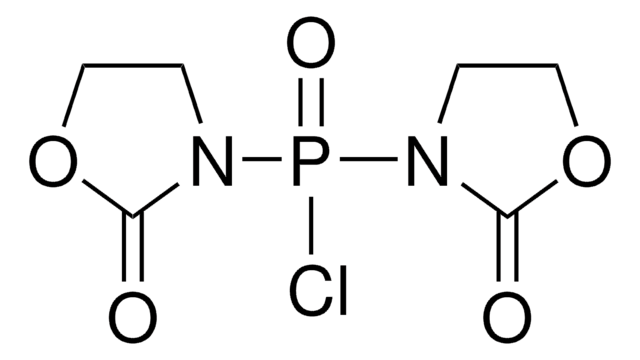472565
Diethyl cyanophosphonate
90%
Sinônimo(s):
DEPC, Diethyl phosphoryl cyanide
About This Item
Produtos recomendados
Ensaio
90%
índice de refração
n20/D 1.403 (lit.)
p.e.
104-105 °C/19 mmHg (lit.)
densidade
1.075 g/mL at 25 °C (lit.)
temperatura de armazenamento
2-8°C
cadeia de caracteres SMILES
CCOP(=O)(OCC)C#N
InChI
1S/C5H10NO3P/c1-3-8-10(7,5-6)9-4-2/h3-4H2,1-2H3
chave InChI
ZWWWLCMDTZFSOO-UHFFFAOYSA-N
Procurando produtos similares? Visita Guia de comparação de produtos
Descrição geral
Aplicação
Outras notas
Palavra indicadora
Danger
Frases de perigo
Declarações de precaução
Classificações de perigo
Acute Tox. 2 Dermal - Acute Tox. 2 Inhalation - Acute Tox. 2 Oral - Eye Dam. 1 - Skin Corr. 1B
Perigos de suplementos
Código de classe de armazenamento
6.1A - Combustible acute toxic Cat. 1 and 2 / very toxic hazardous materials
Classe de risco de água (WGK)
WGK 3
Ponto de fulgor (°F)
176.0 °F - closed cup
Ponto de fulgor (°C)
80 °C - closed cup
Equipamento de proteção individual
Faceshields, Gloves, Goggles, type ABEK (EN14387) respirator filter
Escolha uma das versões mais recentes:
Já possui este produto?
Encontre a documentação dos produtos que você adquiriu recentemente na biblioteca de documentos.
Os clientes também visualizaram
Active Filters
Nossa equipe de cientistas tem experiência em todas as áreas de pesquisa, incluindo Life Sciences, ciência de materiais, síntese química, cromatografia, química analítica e muitas outras.
Entre em contato com a assistência técnica














